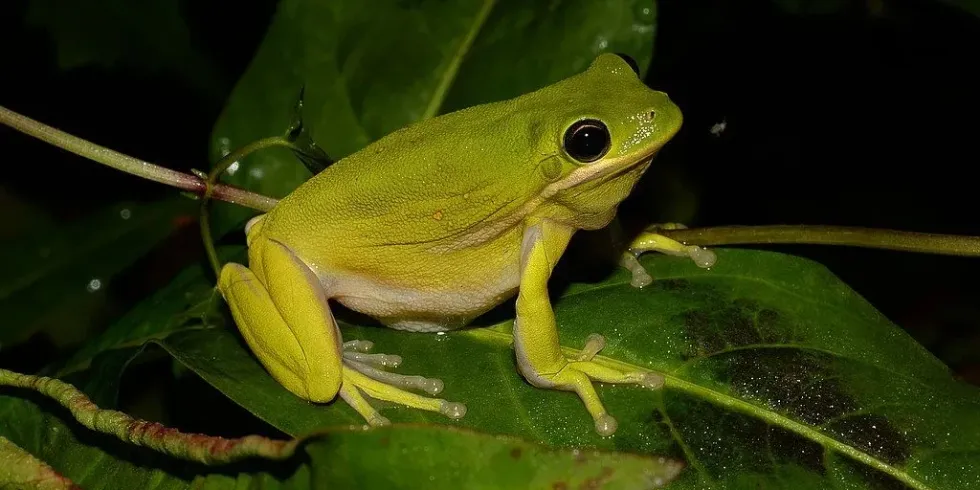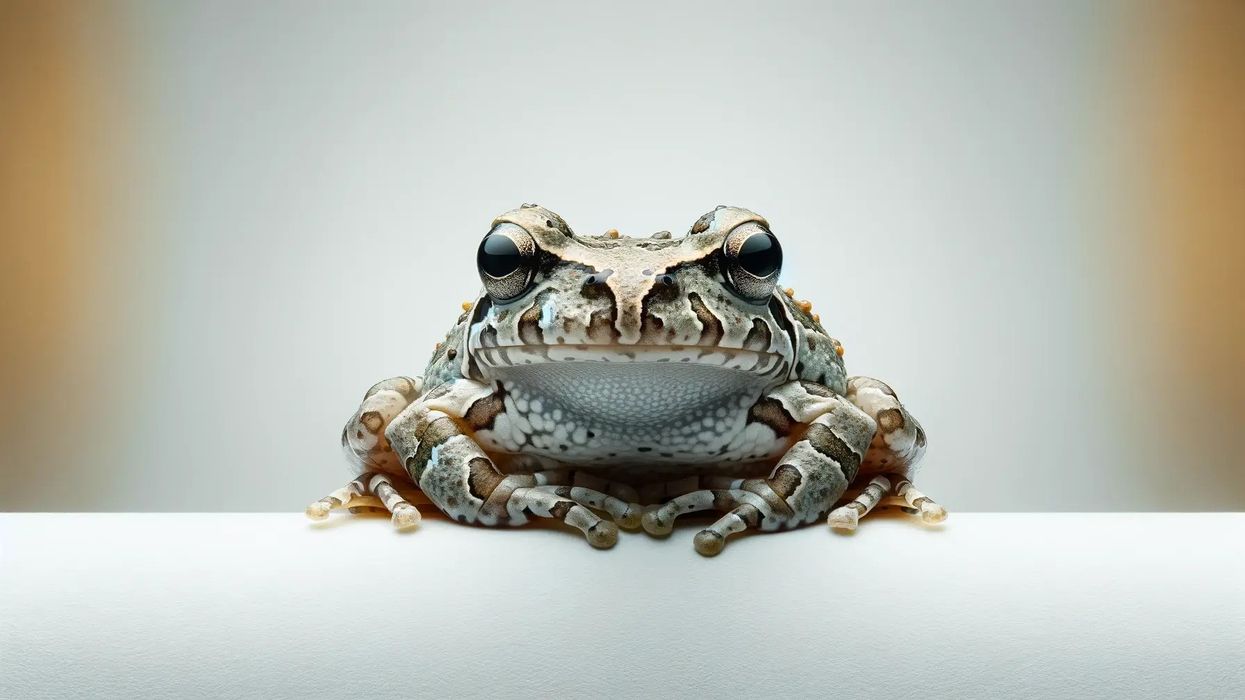How about learning some interesting facts about an arboreal amphibian? Let us meet our little friend, the American green tree frog. The frogs are generally an indicator species which means that any decline in their population indicates the degradation of the frog's habitats.
Their unique vocalization call can be heard as far as one mile away. The green tree frogs eat insects as they are primarily insectivorous. They eat their prey by visually predating them first.
On a lighter note, you can consider these tiny amphibians for providing some free pest control through their feed, including mosquitoes in their range of habitats. The breeding season is when these frog species gather in small groups and move to their breeding habitat.
The Green tree frog holds the stature of being the State Amphibian of Georgia and Louisiana. Their advertisement call for mating sounds more like a nasal honk, and their call is persistent 75 times per minute.
Your journey of discovery is just getting even more fascinating from here. Read on, and after, discover more exciting amphibians here on the red-eyed tree frog and Pacman frog.
Green Tree Frog Interesting Facts
What type of animal is a Green Tree Frog?
The American green tree frogs are a common frog species in Northern America. It is hard to miss these arboreal frogs in your backyard or near your swimming pool because of their loud groaning calls and the noise that echoes through the air. They are likely to spend a significant amount of their life on trees.
What class of animal does a Green Tree Frog belong to?
American green tree frogs belong to the class Amphibia. These animals are characterized by their ability to live on land and water. They are ectothermic or cold-blooded animals, and their skin has special glands to keep the skin moist.
How many Green Tree Frogs are there in the world?
The exact count of their populations is unknown. But these frogs' population is thriving in their native habitats.
Where does a Green Tree Frog live?
The Green tree frogs live in small ponds, marshes, large lakes, and streams. Their range spreads from Central to Southeastern parts of the U.S. from Virginia to Southern Florida to Texas in the center. Their habitat range is also found in Maryland and Delaware.
What is a Green Tree Frog's habitat?
They have a solid affinity for habitats having floating vegetation in abundance like cattails and grasses. In forests with open canopies, they inhabit themselves easily. They are found in temperate climate zones and are highly territorial beings. They prefer living near a water body.
Who do Green Tree Frogs live with?
The American green tree frogs are primarily solitary, and group only for the breeding season. These frogs are nocturnal beings who spend the daytime sleeping on branches and leaves. When they feel threatened, they generate an ear-piercing scream. Their skin is well adapted to camouflage them against vegetation in their surroundings.
In the terrarium setup, you can house a maximum of two to three tree frogs together.
How long does a Green Tree Frog live?
The maximum lifespan recorded for an American green tree frog is six years. These frogs are pretty hardy pets and very suitable for novice owners, too, for low maintenance requirements. It is good to point out that these frog species are prone to diseases like fungal and bacterial infections of the eye and skin.
How do they reproduce?
The breeding is impacted by the length of the day, precipitation levels, and temperature. With these conditions met, these frogs can be bred.
The mating takes place through the male's advertisement call to attract the female. Once the pairing is done, the male holds the female close to enjoin the cloacal openings. This positioning of the male on top of the female is termed amplexus.
The breeding season happens between March and September. The females breed once a year, and the average clutch size is 400 eggs. The eggs usually hatch in a time range of 4-14 days. Parental affiliation is nil amongst these frog species.
What is their conservation status?
The International Union for Conservation of Nature (IUCN) classifies the American green tree frog as a Least Concern species. They have a stable and flourishing population in their native habitats. No significant threat makes them a minor point of concern for the Conservationists.
Green Tree Frog Fun Facts
What do Green Tree Frogs look like?
These frog species have long legs, and their skin is very smooth. Their dorsal side is in shades of lime green or yellowish olive. Some may sport small golden spots on the dorsal side above the green skin. The ventral side is in shades of white or cream. The females are larger than the males.
How cute are they?
These frogs can keep you up at night with their high activity level. But they are fun to watch with their high range of vocalizations. They do not demand to be cuddled; they are sensitive to touch. Their big eyes with a fixed line of vision and mouths that seem smiling always make them an endearing sight to watch.
How do they communicate?
These frogs have unique calls to communicate with one another. There are calls for mating, warnings for threats, and another for rain. They have solid auditory senses and can catch vibrations in the ground. Their communication mode is visual and acoustic, mainly. Their social behavior is evident in their seasonal movement in small groups between foraging and breeding zones.
How big is a Green Tree Frog?
They can grow to a size as big as 2.5 in. They are relatively smaller than the Australian green tree frogs, which grow as much as 4.5 in.
How fast can a Green Tree Frog leap?
Although the exact speed of these species of frogs is unknown, it is recorded that a tree frog, in general, can leap at a speed of 10 mph.
How much does a Green Tree Frog weigh?
These frog species can weigh about 0.6 oz. They are tiny compared to the Cuban tree frogs that weigh up to 2 oz.
What are the male and female names of the species?
There is no specific term for a male or female Green tree frog. They are called male and female Green tree frogs, respectively. The term for a group of frogs together is called an army of frogs.
What would you call a baby Green Tree Frog?
The baby Green tree frog is referred to by many names like tadpoles, polliwog, or froglet. It is interesting to cite that these frogs become herbivorous as tadpoles. The tadpoles take six weeks to become mature frogs.
What do they eat?
American green tree frog food includes insects like mosquitoes, crickets, flies, and other smaller insects. These frogs are very fussy eaters. They like their food or prey to be very active to consume them.
The predators of these frogs are birds, snakes, large fish, and even other frogs. The green tree frogs find an escape route from their predators by hiding in trees.
Are they poisonous?
In general, all frogs secrete toxins on their skin as a defense mechanism. Comparatively, the toxins released by Green tree frogs are fewer.
This toxin called Caerulein only induces diarrhea, vomiting, and depression in some cases. It is assuring to note that these symptoms last only for 30-60 minutes. The toxin of either an American green tree frog or the Australian green tree frog is not fatal.
Unlike the notion of Green tree frogs being poisonous, the Pickerel frog is a more poisonous species of frog found, especially in North Carolina.
Would they make a good pet?
The Green tree frog will make great pets for a novice and an expert owner, alike. But these frogs are not cuddlers; they prefer to be not touched. They wouldn't want to be held instead of being left alone.
They need a minimum of a 10-gallon tank to start with. The optimum temperature needs to be around 70–80 degrees Fahrenheit during the day. During the nighttime, the temperatures can go as low as 65 ° F.
Toxin-free water with a balanced pH value and natural minerals is essential for these frogs. They are moderate swimmers, and a shallow water dish is more than enough for them. Substrates made of coconut fiber or a reptile carpet will be helpful to give an ambient environment for these pet companions.
Did you know...
The Green tree frog holds a vital position in research and education in learning the impact of polychlorinated biphenyl (PCB) contamination in the local habitat.
These frog species use their skin to exchange oxygen.
These frog species can alter their color based on temperature, lighting, and environmental conditions.
Their unique rain calls become a good indicator of rainfall.
What humidity is best for Green Tree Frogs?
These frogs will be comfortable with a humidity level of around 50% or even a little higher. A glass terrarium and a good-quality substrate will help lock in the humidity. A humidity gauge and a thermometer will be a benefit in monitoring the environment for these frogs.
When do Green Tree Frogs hibernate?
The Green tree frogs hibernate in winter. They would hide in deep crevices of trees, amongst rocks, or even some pile of leaf litter that helps them.
Their body is covered in tiny ice crystals when the temperature goes below 5 degrees Celsius; 40% of the water in their body is frozen. You may think that the frog is dead as there is no heartbeat, blood flow, or breathing. Upon the arrival of spring, they thaw themselves and are back in action.
Here at Kidadl, we have carefully created lots of interesting family-friendly animal facts for everyone to discover! Learn more about some other amphibians from our pool frog interesting facts and poison dart frog fun facts pages.
You can even occupy yourself at home by coloring in one of our free printable green Tree Frog coloring pages.










